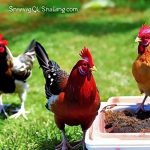Integrating pigs and chickens in a single farming system is a time-tested practice that offers numerous advantages for small-scale agricultural operations and homesteads. This combination has been utilized for centuries due to the complementary nature of these animals. Pigs excel at foraging and can efficiently process food waste while simultaneously aerating the soil.
Chickens, on the other hand, contribute to pest control and provide a valuable protein source through egg production. When implemented correctly, the cohabitation of pigs and chickens can foster a mutually beneficial relationship that enhances the overall farm ecosystem. However, successful integration requires careful planning and management, particularly in areas such as housing design, nutritional requirements, and health monitoring.
Farmers must consider these factors to ensure the well-being of both species and maximize the benefits of this mixed-species approach to animal husbandry.
Table of Contents
- 1 Benefits of Keeping Pigs and Chickens Together
- 2 Considerations for Keeping Pigs and Chickens Together
- 3 Housing and Space Requirements for Pigs and Chickens
- 4 Feeding and Nutrition for Pigs and Chickens
- 5 Health and Disease Management for Pigs and Chickens
- 6 Tips for Successfully Keeping Pigs and Chickens Together
- 7 FAQs
- 7.1 Can pigs and chickens be kept together?
- 7.2 What are the benefits of keeping pigs and chickens together?
- 7.3 What precautions should be taken when keeping pigs and chickens together?
- 7.4 Are there any potential risks of keeping pigs and chickens together?
- 7.5 What are some tips for successfully keeping pigs and chickens together?
Key Takeaways
- Keeping pigs and chickens together can be beneficial for both animals and the farm as a whole.
- Benefits of keeping pigs and chickens together include waste management, pest control, and improved soil health.
- Considerations for keeping pigs and chickens together include potential aggression, space requirements, and dietary needs.
- Housing and space requirements for pigs and chickens should prioritize safety, comfort, and adequate space for both species.
- Feeding and nutrition for pigs and chickens should be carefully managed to meet the specific dietary needs of each animal.
Benefits of Keeping Pigs and Chickens Together
Efficient Use of Resources
One of the primary advantages of keeping pigs and chickens together on a farm is the efficient use of resources. Pigs, being natural omnivores, can consume a wide variety of food, including kitchen scraps, garden surplus, and forage. By allowing pigs to forage in areas where chickens have been, they can help clean up any leftover feed, insects, and weed seeds, reducing the need for additional labor or inputs.
Improved Soil Health and Pest Control
The natural symbiosis between pigs and chickens can also improve soil health and reduce the reliance on external inputs for pest control and soil management. The pigs’ rooting behavior can help to turn over the soil, making it easier for chickens to access insects and other invertebrates. This, in turn, can lead to a more balanced ecosystem and reduced need for external pest control measures.
Increased Income Streams and Sustainability
Keeping pigs and chickens together can also lead to increased income streams for farmers. Pigs can provide a source of meat, while chickens can provide eggs and meat as well. By integrating these two species, farmers can diversify their product offerings and appeal to a wider customer base. Additionally, the manure produced by both pigs and chickens can be used to fertilize crops, creating a closed-loop system that minimizes waste and maximizes the use of on-farm resources. Overall, keeping pigs and chickens together can lead to a more sustainable and resilient farm operation.
Considerations for Keeping Pigs and Chickens Together

While there are many benefits to keeping pigs and chickens together, there are also important considerations to keep in mind to ensure the success of this integrated system. One key consideration is the potential for competition for resources. Pigs and chickens both require access to food, water, and shelter, so it’s important to carefully plan the layout of the farm to minimize competition between the two species.
For example, providing separate feeding areas for pigs and chickens can help reduce conflicts and ensure that each species has access to the resources they need. Another consideration is the potential for disease transmission between pigs and chickens. Both species are susceptible to certain diseases, so it’s important to implement biosecurity measures to minimize the risk of disease spread.
This can include practices such as regular cleaning and disinfection of housing areas, limiting contact between pigs and chickens from different age groups, and monitoring the health of both species closely. Additionally, it’s important to consider the temperament of both pigs and chickens, as aggressive behavior from either species can lead to injuries or stress.
Housing and Space Requirements for Pigs and Chickens
When keeping pigs and chickens together, it’s important to provide adequate housing and space for both species. Pigs require sturdy housing that provides protection from the elements and predators, as well as space to move around and root. For smaller breeds of pigs, such as pot-bellied pigs, a simple three-sided shelter may be sufficient, while larger breeds may require more substantial housing.
It’s important to provide enough space for pigs to exhibit natural behaviors such as rooting and wallowing, as well as access to clean water and a comfortable resting area. Chickens also require appropriate housing that provides protection from predators and the elements, as well as space to roost, nest, and forage. A well-ventilated coop with nesting boxes and roosting perches is essential for chickens, as well as access to an outdoor run or pasture area for foraging.
When integrating pigs and chickens, it’s important to consider the layout of the farm to ensure that both species have access to suitable housing and space without competing with each other. Providing separate areas for pigs and chickens to feed, drink, and rest can help minimize conflicts and ensure the welfare of both species.
Feeding and Nutrition for Pigs and Chickens
Feeding and nutrition are important considerations when keeping pigs and chickens together. Pigs are omnivores and require a balanced diet that includes protein, carbohydrates, vitamins, and minerals. They can consume a wide variety of foods, including grains, fruits, vegetables, and even some animal by-products.
When kept with chickens, pigs can help clean up any leftover feed or food scraps, reducing waste and providing additional nutrition for the pigs. However, it’s important to monitor the diet of both species to ensure that they are receiving adequate nutrition without over-consuming or competing for resources. Chickens also require a balanced diet that includes protein, carbohydrates, vitamins, and minerals.
A typical chicken diet includes a mix of grains, seeds, fruits, vegetables, and protein sources such as insects or commercial feed. When kept with pigs, chickens can benefit from the insects and invertebrates that pigs uncover while foraging, supplementing their diet with additional protein sources. However, it’s important to monitor the feeding areas to ensure that both pigs and chickens have access to appropriate food without competing with each other.
Providing separate feeding areas for pigs and chickens can help minimize conflicts and ensure that both species receive the nutrition they need.
Health and Disease Management for Pigs and Chickens

Minimizing Disease Transmission
Both pigs and chickens are susceptible to certain diseases, making it crucial to implement biosecurity measures to reduce the risk of disease transmission. This includes regular cleaning and disinfection of housing areas, limiting contact between pigs and chickens from different age groups, and closely monitoring the health of both species.
Developing a Health Management Plan
Working with a veterinarian is essential to develop a health management plan that includes vaccination schedules, parasite control, and regular health checks. This plan helps to identify potential health issues early on and take preventative measures to ensure the well-being of both species.
Providing a Healthy Environment
In addition to a health management plan, providing a healthy environment is vital for maintaining the health and welfare of pigs and chickens. This includes providing access to clean water, nutritious food, and suitable housing, as well as minimizing conflicts by providing adequate space and enrichment. By implementing good management practices and monitoring the health of both species closely, farmers can ensure the success of keeping pigs and chickens together.
Tips for Successfully Keeping Pigs and Chickens Together
Keeping pigs and chickens together can be a beneficial practice for small-scale farmers and homesteaders when managed properly. By integrating these two species, farmers can create a symbiotic relationship that benefits both animals and the overall farm ecosystem. To successfully keep pigs and chickens together, it’s important to consider factors such as housing, feeding, health management, and space requirements.
Providing adequate housing and space for both species, monitoring their nutrition closely, implementing biosecurity measures, and monitoring their health are all essential aspects of successfully integrating pigs and chickens on a farm. Overall, keeping pigs and chickens together requires careful planning and management to ensure the welfare of both species. By considering the unique needs of pigs and chickens and implementing good management practices, farmers can create a sustainable system that maximizes resource use and benefits both animals.
With proper planning and attention to detail, keeping pigs and chickens together can be a rewarding practice that contributes to a more resilient farm operation.
If you’re considering keeping pigs and chickens together, you may also be interested in turning a shed into a chicken coop. This article from Poultry Wizard provides helpful tips and advice on how to convert a shed into a suitable living space for your chickens. Learn more about turning a shed into a chicken coop here.
FAQs
Can pigs and chickens be kept together?
Yes, pigs and chickens can be kept together in the same area, as long as proper precautions are taken to ensure their safety and well-being.
What are the benefits of keeping pigs and chickens together?
Keeping pigs and chickens together can provide mutual benefits, such as waste management, pest control, and social interaction for the animals.
What precautions should be taken when keeping pigs and chickens together?
Precautions should be taken to prevent aggression between the animals, provide separate feeding areas, and ensure that the animals have access to appropriate shelter and space.
Are there any potential risks of keeping pigs and chickens together?
Potential risks of keeping pigs and chickens together include the spread of diseases, competition for food and resources, and the risk of injury from aggressive behavior.
What are some tips for successfully keeping pigs and chickens together?
Some tips for successfully keeping pigs and chickens together include providing adequate space, monitoring the animals’ behavior, and regularly cleaning and maintaining their living area.
Meet Walter, the feathered-friend fanatic of Florida! Nestled in the sunshine state, Walter struts through life with his feathered companions, clucking his way to happiness. With a coop that’s fancier than a five-star hotel, he’s the Don Juan of the chicken world. When he’s not teaching his hens to do the cha-cha, you’ll find him in a heated debate with his prized rooster, Sir Clucks-a-Lot. Walter’s poultry passion is no yolk; he’s the sunny-side-up guy you never knew you needed in your flock of friends!







